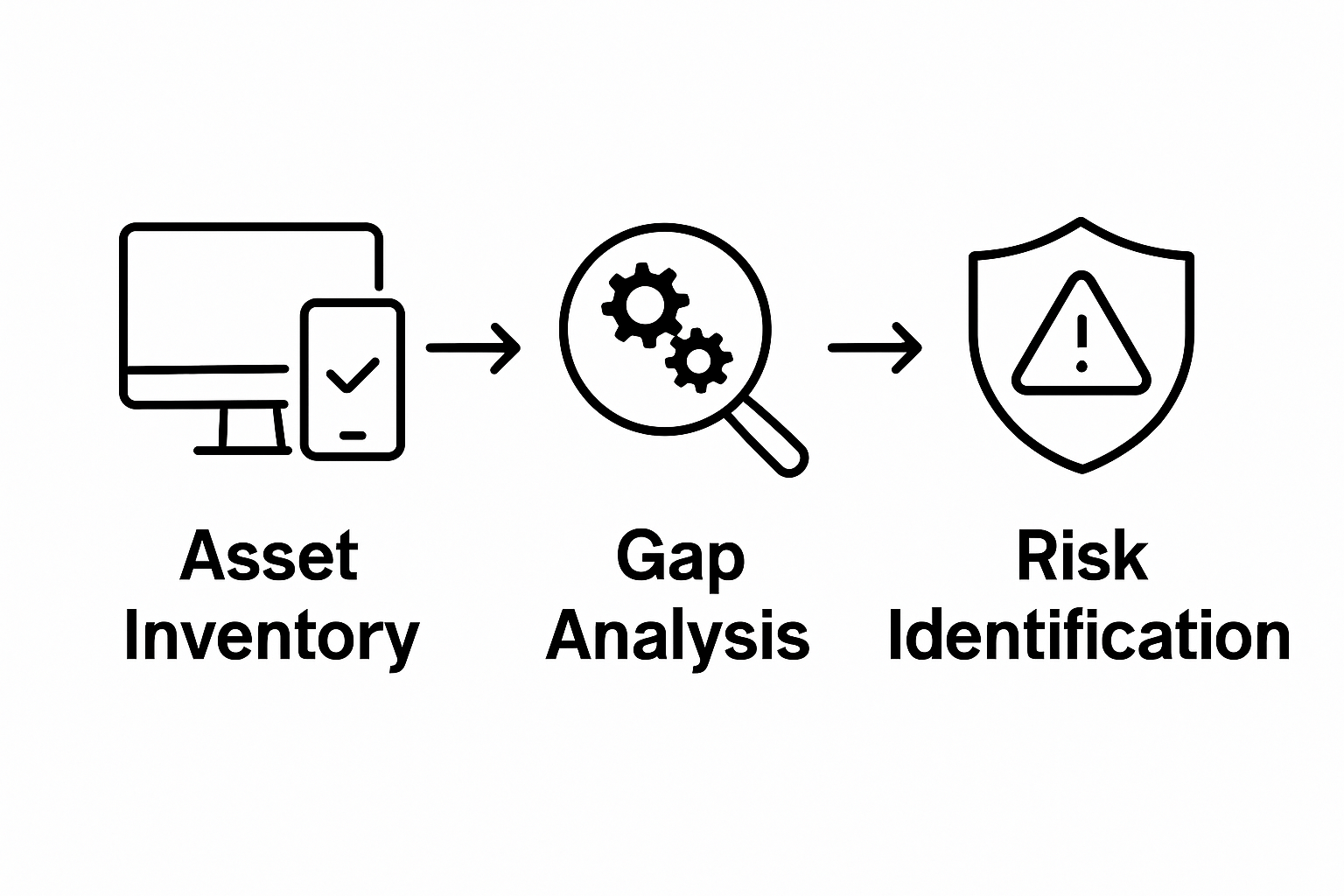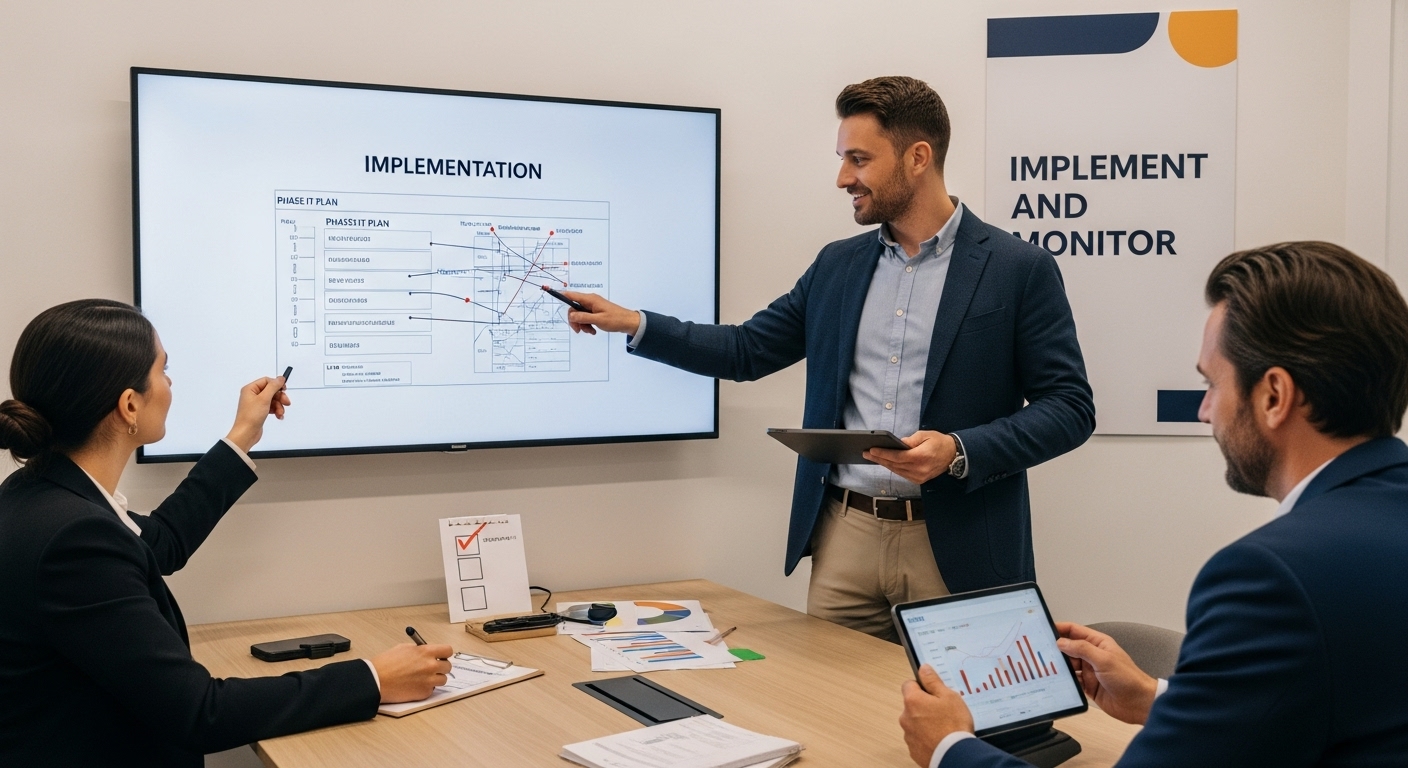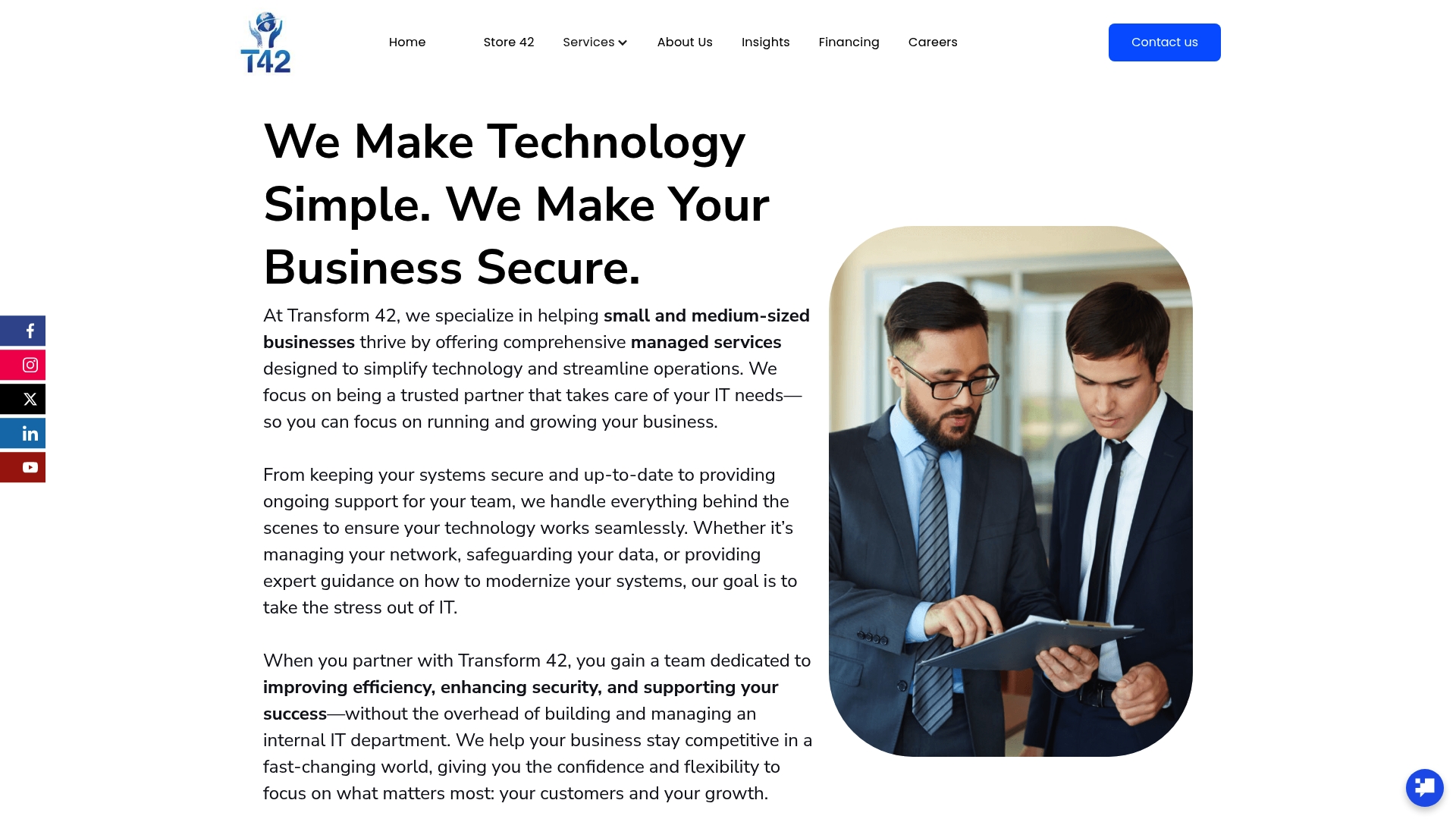
Building a strong IT strategy can decide whether a small business thrives or barely keeps up. Nearly 60 percent of small businesses that suffer a cyberattack go out of business within six months, yet the right technology plan can stack the odds in your favor. Most people think an IT roadmap is just about hardware and software, but the real secret is how each step connects your tech directly to business goals, turning your IT into a driver for lasting growth.
Key PointExplanation1. Assess Current IT EnvironmentConduct a detailed evaluation of existing technologies to identify strengths and weaknesses.2. Define Clear Business GoalsEstablish specific, measurable objectives that align IT strategy with business aspirations.3. Choose Appropriate TechnologiesSelect technologies that best support defined business goals without chasing trends.4. Develop a Comprehensive IT PlanCreate a structured roadmap for technology investments and implementation timelines.5. Continuously Monitor PerformanceImplement KPIs to track effectiveness and adjust strategies in real-time as needed.
Assessing your current IT environment is the critical foundation for developing a strategic technology roadmap. This initial step helps small businesses understand their existing technological infrastructure, identify potential vulnerabilities, and create a clear baseline for future improvements. The assessment process goes beyond simply counting computers and inventorying software it requires a comprehensive examination of your technological ecosystem.
Technology Infrastructure Mapping
Begin by conducting a thorough inventory of all technological assets. This includes hardware like computers, servers, mobile devices, networking equipment, and peripherals. Document each device’s specifications, age, operating system, and current performance levels. Pay special attention to equipment that might be approaching end-of-life status or running outdated software versions. According to the National Institute of Standards and Technology, understanding your current technology landscape is the first step in developing a robust cybersecurity strategy.
Your inventory should also capture critical software applications, cloud services, and digital platforms your business relies on. Create a comprehensive list that includes:
Identifying Operational Gaps and Potential Risks
Once you have mapped your technological resources, analyze how effectively they support your business operations. Evaluate performance bottlenecks, integration challenges, and potential security vulnerabilities. Consider factors like system compatibility, data storage capabilities, network speed, and overall technological efficiency. Look for areas where current technology might be limiting your business growth or creating unnecessary operational friction.
Successful completion of this assessment means you have a detailed, current snapshot of your IT environment. Your documentation should provide clear insights into existing technological capabilities, potential upgrade requirements, and strategic improvement opportunities.
Below is a checklist table to help verify that you have completed a thorough assessment of your current IT environment as described in Step 1.
Assessment TaskDescriptionCompletion StatusInventory All HardwareDocument computers, servers, devices, and specifications[ ]Inventory All SoftwareList business, communication, and productivity applications[ ]Record Asset DetailsCapture device age, OS, performance, and end-of-life status[ ]Identify Outdated SystemsFlag hardware/software for replacement or upgrade[ ]Assess Operational GapsNote integration issues, bottlenecks, and inefficiencies[ ]Evaluate Security RisksLook for vulnerabilities in systems and data protection[ ]Document Current StatePrepare a summary of technology strengths and weaknesses[ ]

Defining clear business goals and objectives is the strategic compass that transforms your IT infrastructure from a mere support function to a powerful growth engine. This critical step bridges the gap between your current technological capabilities and your future business aspirations. Without well-defined objectives, technology investments become scattered and ineffective, potentially wasting valuable resources.
Strategic Goal Alignment
Start by conducting a comprehensive strategic planning session that brings together key stakeholders from various departments. This collaborative approach ensures that your IT strategy reflects the broader organizational vision. Examine your business’s short-term and long-term objectives, focusing on specific outcomes like revenue growth, operational efficiency, customer experience enhancement, or market expansion. According to research from the Small Business Administration, successful strategic planning requires a clear understanding of your business’s unique value proposition and growth trajectory.
Consider developing goals that are SMART: Specific, Measurable, Achievable, Relevant, and Time-bound. For instance, instead of a vague objective like “improve technology,” craft a precise goal such as “reduce customer response time by 40% within 12 months through implementing a unified communication platform.”
Technology Enablement Mapping
Translate your business objectives into specific technological requirements. This involves identifying how technology can directly support and accelerate your strategic goals. Create a detailed mapping that connects each business objective with potential technological solutions. Your mapping should address critical areas such as:
Successful completion of this step means you have a clear, documented set of technology-enabled business objectives. Your goals should be precise, actionable, and directly tied to measurable business outcomes. This foundation will guide subsequent IT strategy development, ensuring that every technological investment purposefully supports your organization’s broader vision and growth strategy.
The following table summarizes main types of business objectives and the typical technology areas that can enable them, providing quick reference during your IT strategy planning.
Business ObjectiveRelevant Technology EnablementRevenue GrowthData analytics, CRM systemsOperational EfficiencyWorkflow automation, productivity suitesEnhanced Customer ExperienceUnified communication platforms, support toolsMarket ExpansionCloud platforms, scalable infrastructureData Security & ComplianceCybersecurity solutions, compliance softwareCost EfficiencyResource management tools, cloud solutionsScalability and Growth PotentialModular software, cloud-based ecosystems
Identifying the right technologies and tools is a pivotal moment in your IT strategy development. This step transforms your business objectives into actionable technological solutions, creating a roadmap that aligns cutting-edge tools with your specific organizational needs. The goal is not to chase the latest trends, but to select technologies that provide tangible value and support your strategic business goals.
Technology Selection Framework
Begin by conducting a comprehensive evaluation of potential technologies through the lens of your previously defined business objectives. This requires a systematic approach that goes beyond surface-level features. Assess each potential technology solution against multiple critical criteria, including compatibility with existing systems, scalability, total cost of ownership, implementation complexity, and long-term support potential. According to Gartner’s technology selection research, successful tool selection involves a holistic view that considers not just immediate functionality, but future adaptability.
Create a detailed comparison matrix that ranks potential technologies based on weighted criteria specific to your business needs. Prioritize solutions that offer flexibility, integrate seamlessly with your existing infrastructure, and provide clear pathways for future growth. This might involve cloud-based platforms, modular software systems, or scalable technological ecosystems that can evolve alongside your business.
Your technology selection should focus on core functional areas that directly impact business performance. Consider tools that address critical needs such as:
Successful completion of this step means you have a carefully curated list of recommended technologies that are not just theoretically sound, but practically aligned with your business’s unique requirements. Your selected tools should demonstrate clear potential to enhance operational efficiency, support strategic objectives, and provide a competitive advantage. Remember that technology selection is not a one-time event, but an ongoing process of evaluation and adaptation that requires continuous reassessment and strategic alignment.
Developing a comprehensive IT plan is the strategic blueprint that transforms your technological vision into a actionable roadmap. This critical step synthesizes the insights from your previous assessments, translating business objectives and technological capabilities into a structured, forward-looking strategy that guides your organization’s technological evolution.
Strategic Planning Framework
Begin by creating a detailed document that serves as your organization’s technological master plan. This plan should be a living document that articulates your technological trajectory, addressing both immediate operational needs and long-term strategic aspirations. Construct a multi-year framework that outlines technology investments, implementation timelines, resource allocation, and expected business outcomes. The plan must be flexible enough to accommodate emerging technologies and shifting business dynamics while maintaining a clear strategic direction.
Your comprehensive IT plan should meticulously detail key components that demonstrate a holistic approach to technological integration. According to the Small Business Administration, effective strategic planning requires a nuanced understanding of how technology supports broader business objectives. Break down your plan into granular yet interconnected sections that address critical technological dimensions:
Implementation and Governance
Establish clear governance mechanisms that ensure your IT plan remains dynamic and responsive. This involves creating accountability structures, defining roles and responsibilities, and implementing regular review processes. Develop quarterly and annual checkpoints to assess plan progress, validate technological investments, and make necessary adjustments. Your implementation strategy should include mechanisms for continuous feedback, allowing the plan to evolve in alignment with changing business needs and technological landscapes.
Successful completion of this step means you have a comprehensive, actionable IT plan that serves as a strategic compass. The document should clearly articulate how technology will drive business growth, enhance operational efficiency, and create competitive advantages. Remember that a great IT plan is not a static document, but a strategic tool that enables your organization to proactively navigate technological challenges and opportunities.
Implementing and monitoring your IT strategy marks the critical transition from planning to execution. This phase transforms your carefully crafted strategic blueprint into tangible technological improvements, requiring meticulous attention to detail, systematic implementation, and continuous performance evaluation. Success hinges on your ability to navigate complex technological changes while maintaining business continuity.
Phased Implementation Approach
Begin by breaking down your comprehensive IT plan into manageable, sequential implementation phases. Prioritize initiatives that deliver immediate business value while minimizing operational disruption. Start with foundational technologies that provide the most significant impact with minimal risk. This might involve upgrading core infrastructure, implementing fundamental security protocols, or introducing productivity-enhancing collaboration tools. Develop a detailed project timeline that includes specific milestones, resource allocations, and expected outcomes for each implementation phase.
According to the Cybersecurity and Infrastructure Security Agency, successful technology implementation requires a structured approach that considers potential risks and mitigation strategies. Create a comprehensive change management plan that addresses potential challenges, including:
Continuous Monitoring and Optimization
Establish a robust monitoring framework that allows real-time tracking of your IT strategy’s performance. Implement key performance indicators (KPIs) that directly align with your original business objectives. Regularly review these metrics to assess technological effectiveness, identify potential improvements, and ensure ongoing alignment with organizational goals. Set up automated monitoring tools that provide comprehensive insights into system performance, security status, and operational efficiency.
Successful completion of this step means you have not just implemented your IT strategy, but created a dynamic, responsive technological ecosystem. Your implementation should demonstrate measurable improvements in operational efficiency, enhanced security, and increased business agility.

Remember that implementation is an ongoing process of refinement, requiring continuous learning, adaptation, and strategic realignment.
Reviewing and optimizing your IT strategy is the critical maintenance phase that ensures your technological approach remains dynamic, responsive, and aligned with evolving business objectives. This step transforms your IT strategy from a static document into a living, breathing framework that adapts to changing technological landscapes and organizational needs.
Strategic Performance Assessment
Initiate a comprehensive review process that goes beyond surface-level metrics. Conduct a holistic evaluation that examines both quantitative performance indicators and qualitative organizational impacts. Analyze key performance metrics, comparing current technological capabilities against your original strategic objectives. This assessment should encompass multiple dimensions, including operational efficiency, cost-effectiveness, cybersecurity resilience, and overall business value generation. Create a detailed scorecard that provides a nuanced view of your IT strategy’s performance, highlighting areas of success and potential improvement.
According to NIST strategic management guidelines, effective strategy optimization requires a systematic approach to identifying and addressing performance gaps. Develop a structured review process that includes:
Continuous Improvement Framework
Establish a proactive optimization methodology that transforms insights into actionable improvements. This involves creating a flexible governance model that allows for rapid strategic adjustments. Implement a continuous improvement cycle that regularly reassesses technological investments, identifies emerging opportunities, and realigns IT capabilities with shifting business priorities. Develop a culture of technological agility that views strategy optimization as an ongoing process rather than a periodic event.
Successful completion of this step means you have not just reviewed your IT strategy, but created a dynamic mechanism for continuous technological refinement. Your optimization process should demonstrate a clear commitment to staying ahead of technological trends, maximizing return on IT investments, and maintaining a competitive technological edge. Remember that the most effective IT strategies are those that can seamlessly evolve in response to changing business landscapes and emerging technological innovations.
Is your small business feeling overwhelmed by technology change or struggling to map out a real IT strategy you can trust? This article highlighted the challenge of taking IT from a chaotic mix of devices and software to a streamlined, growth-focused system. Many small business leaders find it difficult to assess their current state, define SMART goals, and pick technology that actually fits their needs. If you are looking to turn IT pain points like outdated infrastructure, integration issues, and uncertain planning into real opportunities for business growth, let Transform 42 Inc. help guide your journey.

Turn strategic advice into real-world solutions. Visit Transform 42 Inc. to discover how our team can create a custom IT plan for your business. Explore our IT-as-a-Service consulting to experience seamless implementation, hands-on support, and ongoing optimization. Act now and get expert guidance tailored for small and medium businesses—build your competitive advantage today.
To assess your current IT environment, start by conducting a comprehensive inventory of all technological assets, including hardware and software. Document specifications, performance levels, and identify any outdated systems or potential vulnerabilities.
When defining your IT-related business goals, you should ensure they are SMART: Specific, Measurable, Achievable, Relevant, and Time-bound. Consider objectives such as enhancing customer experience or increasing operational efficiency through technology.
To choose the right technologies, evaluate potential solutions against your defined business objectives. Consider criteria such as compatibility with existing systems, scalability, and total cost of ownership. Create a comparison matrix to rank these technologies based on your business needs.
Implement your IT strategy by breaking it down into manageable phases, prioritizing initiatives that offer immediate value. Monitor your strategy by establishing key performance indicators (KPIs) that align with your business objectives, reviewing these metrics regularly for potential improvements.